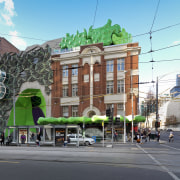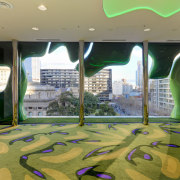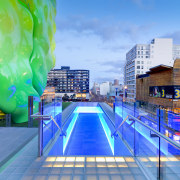Endless possibilities
Like a beautiful mind writ large, RMIT's Building 22 celebrates the wonder of human consciousness beyond artificial intelligence
When the Royal Melbourne Institute of Technology unveiled the Ashton Raggatt McDougall-designed Storey Hall refurbishment, with its shapes and spaces inspired by fractal geometry, there was no denying that a singular piece of architecture had been achieved.
Fifteen years later, the latest joint venture of these two organisations is receiving comparable attention.
Dubbed the Green Brain, the rooftop extension to the RMIT Building 22 is not only a logical continuation of its predecessor, but is also an exploration of thought itself, says Howard Raggatt, founding director of ARM.
"In a way, it's a fairly simple extension of the Penrose tile treatment we devised for Storey Hall next door. On the Storey Hall project, we were working at the forefront of computer-aided design. Now, CAD-CAM has become such an inherent part of design and manufacture that a whole new level of possibility is available to us.
"We were interested in exploring the whole inventive, creative culture of the university being tied up with this idea of a consciousness in matter outlined by the mathematical physicist, Roger Penrose, so it seemed an appropriate conceptual extension to explore the infinite continuation of that imagery to take it beyond the five-fold rotational symmetry of Penrose tiling."
As well as being informed by advances in design, the extension also needed to incorporate a number of sustainable elements.
"Of equal concern to the university was the idea of consciousness, including green consciousness, as a vital part of life in the present day," says Raggatt. "The building was designed using the parameters of the Green Star green building rating system and has achieved 4 Stars."
A 10,000-litre rainwater tank, installed under the floor of the extension, supplies the toilets. Additionally, 5-Star WELLS fittings reduce water consumption, low-energy air exchange systems are in place and the structure's thermal envelope exceeds BCA requirements.
The extension is part of a full interior renovation and links existing conference facilities located in Storey Hall with a purpose-built centre.
"At the time of the Storey Hall refurbishment we built in a number of contingencies such as the inclusion of a lift that would service both spaces that allowed for the incorporation of the roof space of the adjoining Building 22," says Raggatt.
To accommodate the new structure, the existing roof of the building was removed and a significant steel framework erected to support the extension.
One of the benefits of this was the ability to borrow space from the original roof void to install a sunken terrace, says Raggatt.
"Incorporating a sunken terrace means people can get right out to the edge of the building without the need for an upright balustrade element running along the parapet line allowing us to maintain the integrity of the structure. At the same time, it brings the central city into focus, reinforcing the place of the university in the heart of Melbourne."
Credit list
Client
Quantity surveyor
Roofing
Handrails
Flooring
Paints and varnishes
Office furniture
Architect
Cladding
Facade design
Hardware
Blinds
Wall and ceiling coverings
Lighting
Bathroomware
Story by: Justin Foote
Home kitchen bathroom commercial design
Connected to the ocean
Simplified seclusion
At one with the Amazon
















